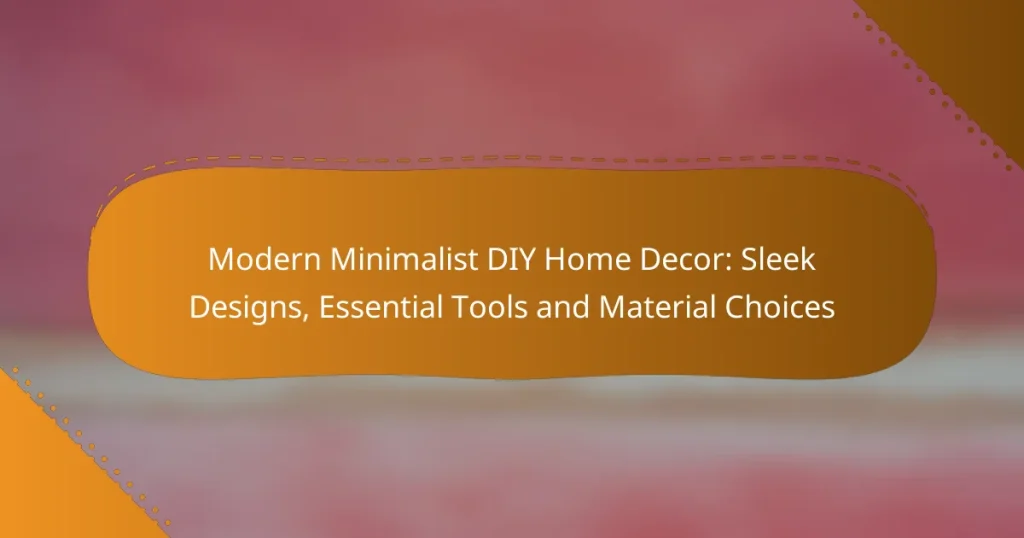In 2023, DIY home decor trends emphasize the importance of creating personalized and functional spaces that reflect individual styles. From the calming effects of biophilic design to the vibrant expression found in maximalism, these trends encourage creativity and self-expression while enhancing the overall aesthetic of your home.
Bohemian Style: Incorporation Techniques, Key Elements and Color Palettes
Cozy Farmhouse Look: DIY Projects, Design Elements and Essential Materials
Staying Ahead in DIY Home Decor: Trends, Techniques and Project Ideas
DIY Home Decor Styles: Mixing, Matching and Personalizing Your Aesthetic
DIY Home Decor Trends: 2025 Highlights and Key Changes
Modern Minimalist DIY Home Decor: Sleek Designs, Essential Tools and Material Choices
What are the top DIY home decor trends in 2023?
The top DIY home decor trends in 2023 focus on creating personalized, functional, and aesthetically pleasing spaces. Key trends include biophilic design, maximalism, vintage revival, minimalist aesthetics, and smart home integration.
Biophilic design
Biophilic design emphasizes the connection between nature and indoor spaces, promoting well-being and tranquility. Incorporating natural elements like plants, water features, and natural light can enhance your home’s ambiance.
To implement biophilic design, consider adding indoor plants, using natural materials like wood and stone, and maximizing windows for natural light. Aim for a balance of greenery and open space to create a calming environment.
Maximalism
Maximalism embraces bold colors, patterns, and eclectic decor, allowing for personal expression and creativity. This trend encourages layering textures and mixing styles to create a vibrant and dynamic space.
When adopting maximalism, focus on combining various elements such as artwork, textiles, and furniture. Don’t shy away from clashing patterns; instead, aim for a cohesive color palette to tie everything together.
Vintage revival
The vintage revival trend celebrates nostalgia by incorporating retro and antique pieces into modern decor. This approach adds character and uniqueness to your home while promoting sustainability through upcycling.
To embrace vintage revival, explore thrift stores, flea markets, and online marketplaces for unique finds. Mixing vintage items with contemporary pieces can create a harmonious and stylish look.
Minimalist aesthetics
Minimalist aesthetics focus on simplicity and functionality, emphasizing clean lines and uncluttered spaces. This trend promotes a sense of calm and order, making it ideal for smaller homes or those seeking a serene environment.
To achieve a minimalist look, choose a neutral color palette and invest in multifunctional furniture. Decluttering and organizing your space can enhance the minimalist vibe, allowing key pieces to stand out.
Smart home integration
Smart home integration involves incorporating technology to enhance convenience and efficiency in home decor. This trend includes smart lighting, thermostats, and security systems that can be controlled remotely.
When integrating smart technology, consider devices that blend seamlessly with your decor. Look for options that offer both functionality and aesthetic appeal, ensuring that technology enhances rather than detracts from your home’s design.
How can I incorporate biophilic design into my home?
Biophilic design can be incorporated into your home by integrating natural elements that connect you to nature. This approach enhances well-being and creates a calming environment through the use of plants, natural materials, and ample natural light.
Use indoor plants
Indoor plants are a fundamental aspect of biophilic design, as they improve air quality and add a touch of nature to your space. Consider using a variety of plants such as succulents, ferns, or snake plants, which are low-maintenance and thrive indoors.
When selecting plants, aim for a mix of sizes and types to create visual interest. Grouping plants together can also enhance their impact, making a small corner feel lush and inviting.
Natural materials
Incorporating natural materials like wood, stone, and bamboo into your decor can significantly enhance the biophilic feel of your home. These materials not only add texture but also evoke a sense of warmth and comfort.
Consider using reclaimed wood for furniture or flooring, which adds character and sustainability. Stone accents, such as a feature wall or countertops, can also bring an earthy element to your interiors.
Large windows for natural light
Large windows are essential for maximizing natural light, which is a key component of biophilic design. They create a seamless connection between your indoor space and the outdoors, allowing you to enjoy views of nature.
When designing or renovating, prioritize window placement to capture sunlight throughout the day. If possible, consider installing floor-to-ceiling windows or sliding glass doors to enhance the flow of light and air into your home.
What are the benefits of maximalism in home decor?
Maximalism in home decor emphasizes bold choices and a rich layering of elements, allowing for a vibrant and personalized living space. This style encourages creativity and self-expression, making it a popular choice for those looking to showcase their unique tastes.
Personal expression
Maximalism offers an opportunity for individuals to express their personality through their decor choices. By mixing various styles, colors, and patterns, homeowners can create a space that reflects their interests and experiences. This approach often leads to a more inviting and dynamic atmosphere.
To effectively showcase personal expression, consider incorporating items that hold sentimental value, such as travel souvenirs or family heirlooms. The key is to curate a collection that tells a story and resonates with your identity.
Colorful environments
One of the defining features of maximalism is the use of vibrant colors to create lively environments. This style encourages the use of bold hues and unexpected color combinations that can energize a space. A well-executed maximalist design can transform a dull room into a visually stimulating area.
When selecting colors, aim for a balance between bright and muted tones to avoid overwhelming the senses. Consider using accent walls or colorful furniture pieces to introduce pops of color without dominating the entire space.
Layered textures
Layering textures is essential in maximalist decor, as it adds depth and interest to a room. Combining various materials, such as wood, metal, fabric, and glass, can create a rich sensory experience. This technique helps to break up visual monotony and invites touch and interaction.
To achieve a layered look, mix different textiles like velvet cushions, woven throws, and patterned rugs. Be mindful of the overall harmony; while variety is key, maintaining a cohesive color palette will ensure that the space feels unified and thoughtfully designed.
How to choose vintage decor items?
Choosing vintage decor items involves identifying pieces that resonate with your personal style while also considering their condition and authenticity. Look for items that not only fit your aesthetic but also tell a story or have historical significance.
Visit local thrift stores
Local thrift stores are treasure troves for vintage decor. They often carry a wide range of items, from furniture to decorative pieces, at affordable prices. Regular visits can yield unique finds as inventory changes frequently.
When shopping, inspect items for quality and potential repairs. Don’t hesitate to negotiate prices, especially for larger items that may require additional investment for restoration.
Attend estate sales
Estate sales can provide access to high-quality vintage decor items that are often sold at reasonable prices. These sales typically feature a variety of household goods, including furniture, art, and collectibles.
Arrive early to get the best selection and be prepared to act quickly, as desirable items can sell fast. Bring cash for easier transactions, and consider asking about any items that may not be on display but are available for sale.
Online marketplaces like Etsy
Online marketplaces such as Etsy offer a vast selection of vintage decor items from various sellers. You can find unique pieces that may not be available locally, often with detailed descriptions and seller ratings to help guide your purchase.
When shopping online, pay attention to shipping costs and return policies. Look for sellers who provide clear photographs and descriptions to ensure you know what you’re getting before making a purchase.
What are the key elements of minimalist aesthetics?
Minimalist aesthetics focus on simplicity, functionality, and a clean design. Key elements include neutral color palettes, functional furniture, and decluttered spaces that create a serene environment.
Neutral color palettes
Neutral color palettes are foundational to minimalist design, often featuring shades like white, beige, gray, and soft earth tones. These colors promote a sense of calm and spaciousness, making rooms feel larger and more inviting.
When selecting a neutral palette, consider using varying shades to add depth without overwhelming the space. For example, pairing a light gray wall with darker gray furniture can create a sophisticated yet understated look.
Functional furniture
Functional furniture is essential in minimalist aesthetics, prioritizing practicality and simplicity over ornate designs. Pieces should serve multiple purposes, such as a coffee table that doubles as storage or a sofa bed for guests.
When choosing furniture, look for clean lines and a streamlined silhouette. Materials like wood, metal, and glass are popular, as they contribute to a light and airy feel while remaining durable.
Decluttered spaces
Decluttered spaces are a hallmark of minimalist design, emphasizing the importance of keeping only what is necessary and meaningful. This approach not only enhances visual appeal but also promotes mental clarity.
To achieve a decluttered space, regularly assess your belongings and remove items that do not serve a purpose or bring joy. Utilize smart storage solutions, such as built-in shelves or hidden compartments, to maintain an organized environment.
How can smart home technology enhance decor?
Smart home technology can significantly enhance decor by integrating functionality with aesthetics. Devices like smart lighting and automated systems not only improve convenience but also allow for personalized ambiance and style adjustments in any living space.
Smart lighting solutions
Smart lighting solutions enable homeowners to control their lighting through apps or voice commands, creating a versatile environment. These systems can adjust brightness, color, and timing, allowing for tailored moods that complement decor themes.
Consider options like LED smart bulbs, which can be programmed for various settings, or smart switches that control existing fixtures. Many systems are compatible with popular platforms like Google Home or Amazon Alexa, making integration seamless.
When selecting smart lighting, look for features such as energy efficiency ratings and compatibility with other smart devices. Avoid overly complex setups that may require extensive technical knowledge; simpler systems often provide the best user experience and flexibility.






